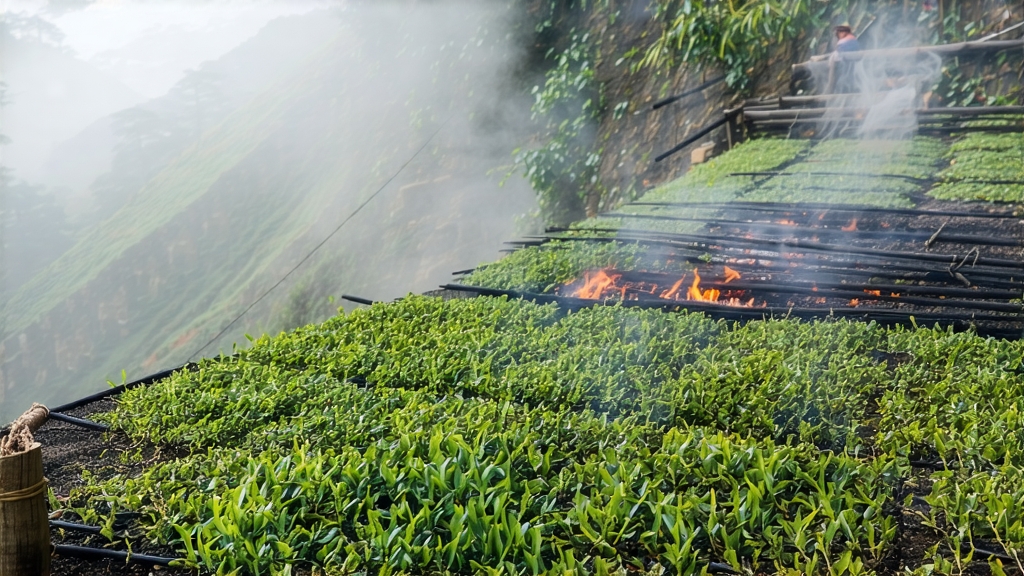
Few beverages carry as much myth and aroma as Lapsang Souchong, the original black tea that astonished Europe in the early seventeenth century and still smolders in the collective memory of tea lovers today. Grown in the rocky folds of the Wuyi Mountains in China’s Fujian Province, this tea is instantly recognizable by its heady perfume of pine and longan, a fragrance that seems to transport the drinker to a campfire under cedar stars. Yet behind the smoke lies a layered history of trade wars, imperial edicts, and meticulous craft that turned a humble leaf into the world’s first fully oxidized tea.
Historical records suggest that black tea as a category was born here around 1568, when passing armies interrupted the usual green-tea drying schedule in Tongmu village. To save the harvest, farmers rushed the leaves over fresh pine fires, inadvertently creating a dark, stable tea that could survive the long sea voyage to Amsterdam and London. By the time the Dutch East India Company landed its first cargo in 1610, “bohea” (a corruption of “Wuyi”) had become a luxury item in European courts, priced higher than silver and credited with curing everything from headaches to heartbreak. The British East India Company later copied the technique in India and Sri Lanka, but the original pine-smoked leaf from Tongmu remains the benchmark against which all black teas are measured.
Strictly speaking, only leaf picked within the 60-square-kilometer national-park core of Tongmu can be called Zhengshan Xiaozhong—“Original Mountain Small Variety.” Plants here are mainly the small-leaf Caicha cultivar, a slow-growing bush that roots directly into mineral-rich volcanic tuff. The cool, foggy climate shortens the growing season, concentrating amino acids and sugars that later balance the assertive smoke. Outside this micro-zone, similar methods produce Waishan Xiaozhong, a pleasant yet lighter tea that lacks the resinous depth of the original.
Craft begins in mid-May, when only the tender two-leaf-and-a-bud sets are plucked before 10 a.m. After a short withering on bamboo trays in the shade, the leaves are rolled on rattan mats to rupture cell walls and initiate oxidation. What follows is unique in tea lore: the damp leaf is loaded onto multilevel wooden racks suspended over pinewood fires that have been reduced to a low, resinous smolder. For up to eight hours the tea absorbs volatile phenols and terpenes, while the heat fixes the coppery color and chocolate sweetness. Master smokers control the balance by adjusting the ratio of fresh pine to ember, the depth of the leaf layer, and even the humidity of the night air. A final charcoal bake the next morning refines the texture, leaving the finished leaf glossy, chocolate-black, and fragrant with notes of smoked lychee, cacao, and wet slate.
Western packaging often exaggerates the smoke, leading casual drinkers to expect a liquid campfire. Properly made Lapsang Souchong, however, is nuanced: the cup glows amber-mahogany, the aroma layered like a Speyside whisky—first pine, then honey, then a lingering floral lift reminiscent of orchid. On the palate it is brisk yet round, with a malt sweetness that arrives after the initial smoky greeting and a mineral finish borrowed from Wuyi’s igneous soils. The best grades, labeled as “unsmoked” or “light smoke,” receive only a whisper of pine, allowing the natural fruit and cocoa character to dominate.
To unlock these subtleties, treat the tea like a fine Burgundy rather than a breakfast builder. Use soft, neutral water around 90 °C; boiling water can varnish the aromatics into bitterness. A small 120 ml gaiwan or Yixing pot allows repeated short infusions that evolve from smoke to fruit to malt. Start with 4 g of leaf, rinse once to awaken the leaf, then steep 8 s, 12 s, 18 s, 30 s, and so on, adding three seconds each round. The first pour is incense and pine sap; by the third, dried longan and dark chocolate emerge; the fifth may reveal a surprising note of raw walnut and iris. If you prefer Western style, 2.5 g per 250 ml at 88 °C for three minutes yields a gentle introduction, but do not squeeze the bag—aggression extracts creosote.
Pairing food with Lapsang Souchong is an adventure in contrast. Its smoky backbone complements the saltiness of aged Gouda, the fat of